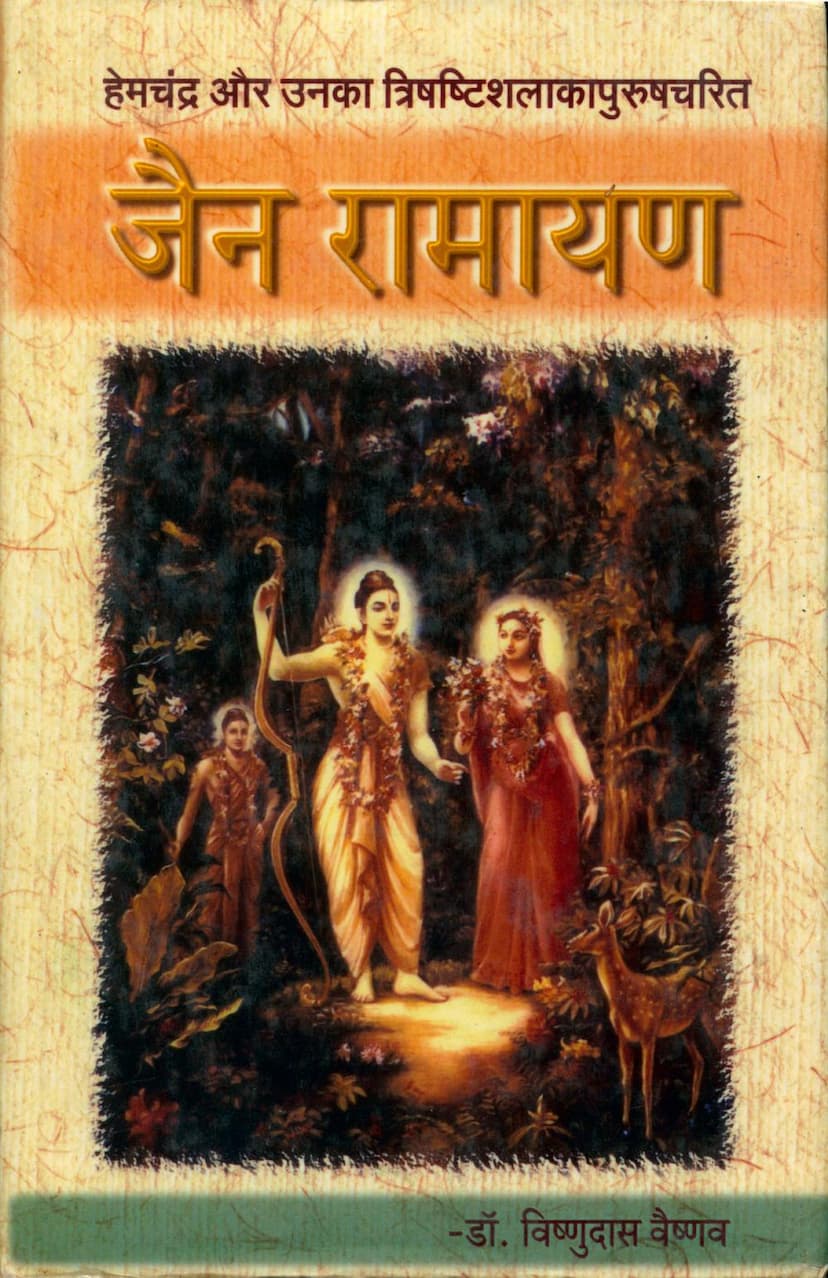Jain Ramayan
Added to library: September 2, 2025

Summary
This document is the book "Hemchandra Aur Unaka Trishashtishalakapurushcharita (Jain Ramayan)" by Dr. Vishnudas Vaishnav, published by Shanti Prakashan in 2001. The book is a comprehensive study of Hemchandra's Trishashtishalakapurushcharita, particularly its seventh part, which is known as the Jain Ramayana.
Here's a breakdown of the book's content based on the provided text:
Book Title: Hemchandra Aur Unaka Trishashtishalakapurushcharita (Jain Ramayan) Author: Dr. Vishnudas Vaishnava Publisher: Shanti Prakashan Publication Year: 2001
Core Subject: The book focuses on the Jain tradition's interpretation of the Ramayana, primarily through the lens of Hemchandra's work, the Trishashtishalakapurushcharita, specifically its seventh part, often referred to as the Jain Ramayana. It aims to bring the "Jain Ramayana" to the public.
Author's Background:
- Dr. Vishnudas Vaishnava holds an M.A. and Ph.D.
- He is the Head of the Hindi Department (Undergraduate and Postgraduate) at Shri Ambaji Arts College, Kumbhariya-Ambaji, Banaskantha, North Gujarat.
- He was the first research student to receive a Ph.D. from North Gujarat University for his thesis on the comparative study of Trishashtishalakapurushcharita (Jain Ramayana) and Tulsidas's Ramcharitmanas.
Key Themes and Chapters:
The book is structured into seven chapters, each exploring different facets of Hemchandra and the Jain Ramayana:
-
Jain Ramayana Tradition: This chapter discusses the diversity of Jain Ramayana narratives available in Sanskrit, Prakrit, and Apabhramsha, establishing the context for Hemchandra's work. It highlights the significance of Hemchandra's Trishashtishalakapurushcharita, Parva 7 within the broader Jain Ramayana tradition, comparing its importance to that of Ramcharitmanas in the Brahmanical tradition. It also mentions earlier Jain poets who contributed to the Ramayana narrative.
-
Personality and Works of Acharya Hemchandra: This chapter delves into Hemchandra's life, highlighting significant events and various aspects of his personality. It provides a foundation for understanding his extensive literary output.
-
Philosophy of Jain Ramayana: This chapter examines the philosophical underpinnings of the Jain Ramayana. It discusses the nature of philosophy, its relation to life, Jain philosophy in general, and specifically how these philosophical concepts are integrated into the Jain Ramayana.
-
Storyline of Jain Ramayana: This is a core chapter detailing the narrative of the Jain Ramayana, covering characters like Ravana (birth, education, conquests) and Rama (birth, education, youth valor, marriage to Sita), the context of Rama's exile, Sita's abduction, the search for Sita, the friendship with Vanaras, the war with Ravana, and their return to Ayodhya.
-
Poetic Excellence of Trishashtishalakapurushcharita, Parva 7 (Jain Ramayana): This chapter analyzes the artistic aspects of the work, including its expression of emotions (rasa), metrical structure (chhanda vidhan), use of figures of speech (alankar vidhan), descriptive skill (varnan kaushal), language, dialogue, poetic form (kavya-rup), and maxims (suktiyan).
-
New Innovations of Trishashtishalakapurushcharita, Parva 7 (Jain Ramayana): This is a crucial chapter highlighting the unique elements and departures from the traditional Brahmanical Ramayana narrative. It points out differences such as:
- Detailed accounts of Ravana's birth and youth.
- The affectionate depiction of Hanuman's mother, Anjana.
- Descriptions of Hanuman's marriages to thousands of maidens.
- The grand history of Rama's ancestors.
- Dasharatha's conquest of Magadha.
- New episodes concerning Rama's exile.
- Rama's journey to Lanka via the sky route, not by building a bridge.
- Laxmana being incapacitated by Ravana himself, not by Meghnada.
- Laxmana's unconsciousness being cured by the water of Vishalya, not by Sanjeevani brought by Hanuman.
- Ravana being killed by Laxmana, not Rama.
- Rama and Sita residing in Ravana's palaces for six months.
- Laxmana's coronation as the first ruler of Ayodhya upon their return.
- Laxmana having sixteen thousand queens and Rama also having many queens.
- Sita pulling out her own hair and converting to Jainism.
- All characters in the Ramayana tradition ultimately converting to Jainism.
-
Conclusion: The final chapter likely summarizes the findings and reiterates the significance of Hemchandra's Jain Ramayana. It emphasizes the need for such ideals presented in the Ramayana for guiding contemporary humanity.
Overall Significance:
The book is presented as a significant contribution to the study of Jain Ramayana literature. It aims to make Hemchandra's Trishashtishalakapurushcharita, Parva 7 (Jain Ramayana) accessible to a wider audience in a simpler language, bridging the gap between academic research and popular understanding. The author acknowledges the influence of earlier Jain Ramayana traditions and highlights the unique philosophical, narrative, and poetic contributions of Hemchandra. The book also emphasizes the need to understand the moral and spiritual lessons embedded in the Ramayana narrative for personal and societal betterment.